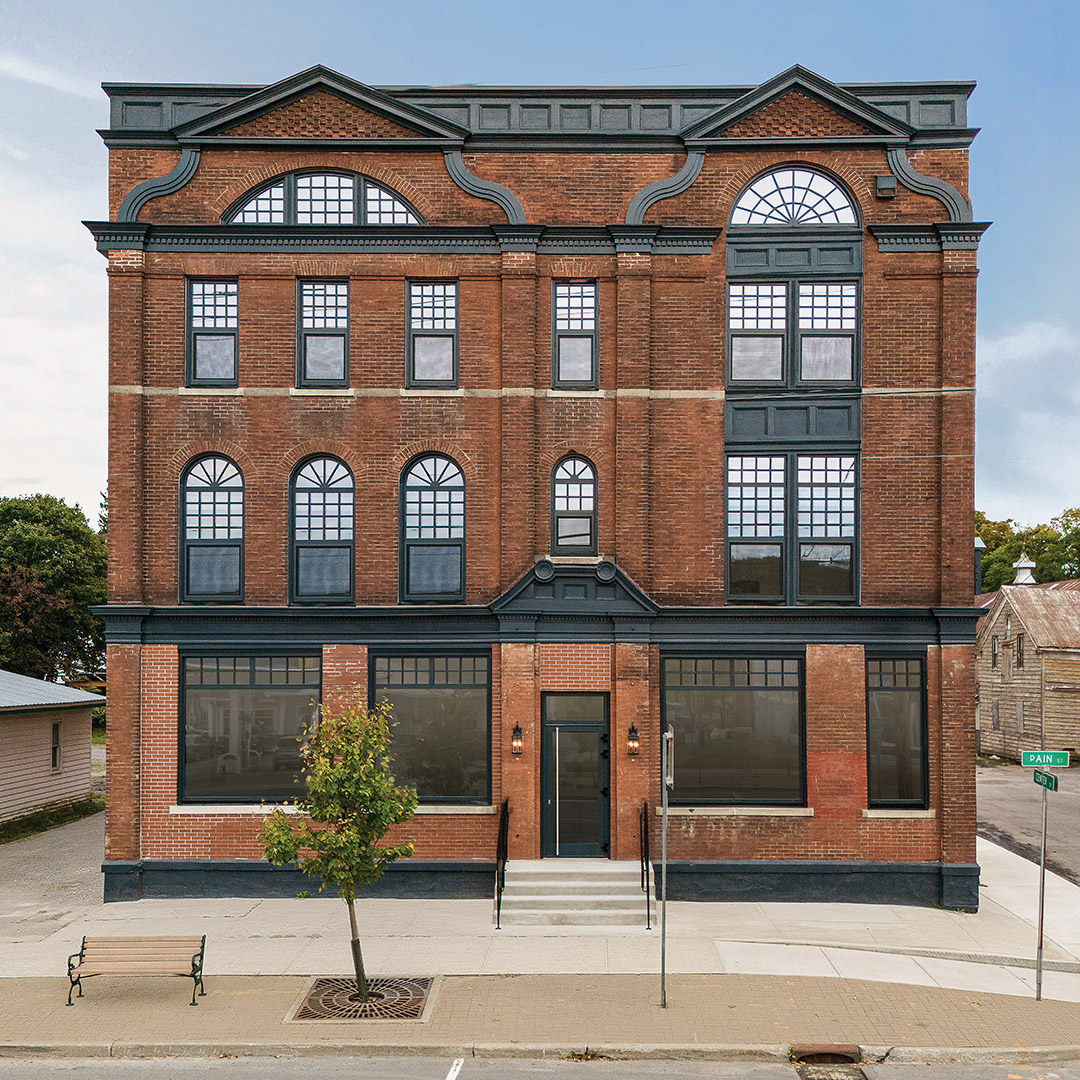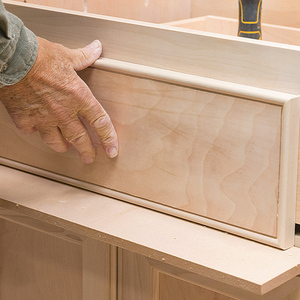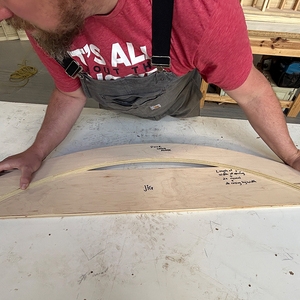Lighting in the “closet,” and the code

If a spacious “dressing room” has built-in wardobes and drawers and cubbies all round its walls, does that make it a “closet” and therefore subject to the code requirement that prohibits “exposed” lighting such as ceiling-mounted fixtures or recessed cans?



















Replies
Wasn't there a sq ft specification? Sounds vaguely familiar...
PaulB
http://www.finecontracting.com
I don't know the new code applicable, but here it has been exposed bulb only-verbotten.
Cans, enclosed fluorescent or fixture with a cover-ok.
A Great Place for Information, Comraderie, and a Sucker Punch.
Remodeling Contractor just outside the Glass City.
http://www.quittintime.com/
Hmmm... a quick glance seems to say it is only defined as "small" storage space :SPaulB
http://www.finecontracting.com
Are regular recessed lights allowed in the closet or "small" storage space? Or only with a lens/cover?Mind you anything would be an improvement over the naked bases with the open bulb the last guy put in. But it would be fun to be compliant for the next family.'Man who say it cannot be done should not interrupt man doing it' ~ Chinese proverb
View Image
Cans are allowed, needn't be covered...PaulB
http://www.finecontracting.com
might check..must be a local thingHere in Des Moines I was dinged last year, 2 walk ends, BI required covered cansWe put them in and I believe they later "disappeared"NEC section 410.8 (B) Luminaire (Fixture) Types Permitted (1) A surface-mounted or recessed incandescent luminaire (fixture) with a completely enclosed lamp.410.8 (C) Luminaire (fixture) types not permitted. Incandescent luminaires (fixtures) with open or partially enclosed lamps and pendant luminaires (fixtures) or lampholders shall not be permitted.410.16
(A)
(1) A surface-mounted or recessed incandescent luminaire
with a completely enclosed lamp
Barry E-Remodeler
Sheesh, I stand corrected it seems... never been called on that one, guess I was lucky. Was just looking over the code drawings and they apparently make some stipulations based on clearances and whether it's a "clothes closet". Guess I must have either slipped through a loophole, or just had a laid back inspector... as common as a tooth fairy :PPaulB
http://www.finecontracting.com
First time i had been called on it also. I remember asking the BI why, the can is in the middle of the closet not over any shelves..can't remember his answer. My electrician hadn't thought of it and had to order the glass
Barry E-Remodeler
Yeah, I always thought it was a shelf clearance issue as well. Reading it over again, I see my misunderstanding. The drawing legend is "recessed incandescent" only elsewhere does it say they have to be covered regardless of clearance. Not that I would bother but I wonder if putting a CFL in a recessed fixture buys you a pass...
Anyway, thanks for the correction. Odd thing was I did this just a while back in a job that got inspected, a kitchen pantry closet. Maybe he didn't catch that there was a light in there at all...PaulB
http://www.finecontracting.com
"Not that I would bother but I wonder if putting a CFL in a recessed fixture buys you a pass..."No, it is the type of fixture, not the bulb. The bulb can always be changed.
"Odd thing was I did this just a while back in a job that got inspected, a kitchen pantry closet."Only Clothes.And don't say anything to the BI.Next thing someone will get the idea that flour is stored their and flour dust is explosive so now we will need explosion proof systems..
William the Geezer, the sequel to Billy the Kid - Shoe
Before you run out and cut a can into your ceiling, looks like I made my annual error ;)PaulB
http://www.finecontracting.com
Thanks. Say two Hail Piffins and all will be forgiven!I thought I recalled a recent article saying they needed to be covered, I suppose as protection against the rogue hanger or shoe attack.'Man who say it cannot be done should not interrupt man doing it' ~ Chinese proverb
View Image
Gives a whole new meaning to "nooooooo wire hangerssssssssss".PaulB
http://www.finecontracting.com
There is a distance rule in the code; as in the combustible material must be no closer than x" to a certain part of a typical light fixture. Your electrician should be well versed on this. I only recently encountered exactly this in CT and the electrician had a good handle on it.
The thing is that even if the clearance is met it still needs to be covered, which is news to me for a can. Ah well, just when I thought I knew everything :PPaulB
http://www.finecontracting.com
w t.............heck..........do I know. Just trying to look like a know it all.
Well... you clearly knew more than I did ;)
PaulB
http://www.finecontracting.com
If you can place the incandescents where they will be 18" from any combustibles is my understanding.
Welcome to the
Taunton University of Knowledge FHB Campus at Breaktime.
where ...
Excellence is its own reward!
That had always been my understanding as well but we're both w...wwwrrr...wrrrrrrro...
wrong again :S PaulB
http://www.finecontracting.com
I believe that the NEC says that incandescent bulbs in closets must be fully enclosed. Florescent bulbs can be exposed - or at least they allow it here. Also, 12" of clearance is required for florescent fixtures and and 24" for incandescent. Can lights are OK - again as long as the bulb is covered. I believe that pendant style lights are not allowed.
From a practical standpoint can lights are more for task lighting than general room lighting. Right now on what I'm building the designer likes can lights and has them in the hallway. The only problem is that a can light with an 8' ceiling only lights maybe a 6'x6' circle, so the hallway which is maybe 12' long is poorly lit, but I guess someone thinks it "looks good" :-).
When can lights are desired in specific task areas, sometimes it is better to combine can lights with other style lights in order to effectively light the entire area.
Edited 11/23/2009 7:33 am ET by Matt
Well I guess if you want something porely lit, can lights is the way to do it.
A strong nation, like a strong person, can afford to be gentle, firm, thoughtful, and restrained. It can afford to extend a helping hand to others. It's a weak nation, like a weak person, that must behave with bluster and boasting and rashness and other signs of insecurity. --Jimmy Carter
A little hard for me to imagine the top shelf of a closet being well lit by ceiling mounted can lights with the proper clearence. OTOH cans can light an area fine as long as there are a lot of them. Personally, I haven't built any houses that had 6 or 8 lights in a closet... :-)
I've done a couple walk ins with four cans that lighted things well.five walk-ins now that I think more on it.
One of them only had two cans but there was a window too
Welcome to the Taunton University of Knowledge FHB Campus at Breaktime. where ... Excellence is its own reward!
Last I checked, exposed bulbs are off limits, but enclosed fixtures are OK. Don't remember the exact wording, but the distance regs say you can't mount an incandescent light any closer than 12" from the front of any shelf. That drops to 6" for a flourescent or recessed cans. The distances listed are measured between a plumb line from the fixture and the front of the shelf, and it applies all the way to the floor.
The code has an example picture that explains it a whole lot better than the words.
Mike Hennessy
Pittsburgh, PA
Everything fits, until you put glue on it.
From the 2008 NEC410.16 Luminaires in Clothes Closets.
(A) Luminaire Types Permitted. Listed luminaires of the following types shall be permitted to be installed in a closet:
(1) A surface-mounted or recessed incandescent luminaire with a completely enclosed lamp
(2) A surface-mounted or recessed fluorescent luminaire
(3) Surface-mounted fluorescent or LED luminaires identified as suitable for installation within the storage areahandbook commentary
New in the 2008 Code, LED lighting, a new technology with a very low heat source, is now permitted if listed for closet use,(B) Luminaire Types Not Permitted. Incandescent luminaires with open or partially enclosed lamps and pendant luminaires or lampholders shall not be permitted.(C) Location. The minimum clearance between luminaires installed in clothes closets and the nearest point of a storage space shall be as follows:
(1) 300 mm (12 in.) for surface-mounted incandescent or LED luminaires with a completely enclosed light source installed on the wall above the door or on the ceiling
(2) 150 mm (6 in.) for surface-mounted fluorescent luminaires installed on the wall above the door or on the ceiling
(3) 150 mm (6 in.) for recessed incandescent or LED luminaires with a completely enclosed light source installed in the wall or the ceiling handbook commentary
The requirement of 410.16(C)(3) results from tests that have shown that a hot filament falling from a broken incandescent lamp can ignite combustible material below the luminaire in which the lamp is installed. (4) 150 mm (6 in.) for recessed fluorescent luminaires installed in the wall or the ceiling
(5) Surface-mounted fluorescent or LED luminaires shall be permitted to be installed within the storage space where identified for this use. handbook commentary
Note that the clearance measurement for each requirement in 410.16(C) is to the luminaire, not to the lamp itself.
A luminaire in a clothes closet is not mandatory; if one is installed, however, the conditions for installation are as required by 410.16(C).
The requirements of 410.16(C) apply to incandescent, fluorescent, and LED lighting in clothes closets of various kinds of occupancies. The requirement is intended to prevent hot lamps or parts of broken lamps from coming in contact with boxes, cartons, blankets, and the like, stored on shelves and with clothing hung in closets.
Now that's as clear as mud! ;-)
The illustration I recall looking at is related to 412.16(c), and that shows that merely installing the light 12" or more above a shelf doesn't comply. It has to be 12" (or 6", as the case may be) as measured horizontally from the front of the shelf to a line plumb with the edge of the light.
Otherwise, someone could simply stack stuff on the shelf until it touched the light -- which is what this code section is designed to prevent.Mike HennessyPittsburgh, PAEverything fits, until you put glue on it.
Hey, if the electric code was easy to understand everyone could do it.
Just thought I would share a real life story on this subject. I'm a lawyer now, and a few years back I represented a landlord who was being sued concerning a fire in a three family aparment building he owned. The closet on one of the tenant units had a single exposed bulb - and the tenants stacked the top shelves of the closet full of garbage bags full of clothes, up to the ceiling. The bulb was left on one night, the bags came in contact with the lightbulb, they caught fire, and the building went up in flames.
The man who lived upstairs surrived with terrible burns; the child upstairs also survived, badly burned; his mother, who carrried him outside, was killed.
I'm not trying to ruin your day by that story, but just to show the real life impact of these code issues. Who would think a closet light would be that important? I certainly didn't before I had that case -
Just ran across this yesterday. Electricians had 2 florescent closet lights mounted within 4" of the closet shelves. It was kinda a weird deal because they were under stairs closets with sloped ceilings. It wasn't really their fault since they didn't know where the shelving was going (although the shelves were there when they installed the fixture). Based on remembering what you wrote, I told them to change it without even thinking about it for more than a second. I guess a coupla sheetrock repair is way better than a law suit or worse :-)
Well, maybe I accomplished something this week after all!
You guys are tough.
So let me get this right. Any room, no matter what it is called, in which one might keep clothing, even if that clothing is kept in a behind-closed-door cabinet, cannot have exposed bulb incandescent lighting.
Right?
A bedroom with a dresser and the clothes stored inside, would mean that that bedroom may not have lighting other than fully clad?
Same for a foyer with a clothes closet in it?
Same for a mudroom with clothes hanging of any types? Rods, hooks, whatever.
BTW, how exactly does that hallway with the fully-enclosed storage cabs and drawers, differ from a bedroom with dressers, or a mudroom with clothes hooks and rods, or a foyer with a front hall closet?
And what about a linen closet in a bathroom? May not that bath have exposed-bulb fixtures?
And a linen closet in a hallway, with an ordinary recessed fixture containing a 50W incandescent floodlight, that fixture centered on that closet's door? Illegal?
View Image
"A stripe is just as real as a dadgummed flower."
Gene Davis 1920-1985
I was told the reason that even a can needs to be covered is that if a hot bulb breaks or blows out, the peices won't land on something combustible.
No, the code only includes the clothes hanging space. You can have bare incandenscents in a closet if it is outside the hanging space.I will try and post a copy of the code tomorrow..
William the Geezer, the sequel to Billy the Kid - Shoe
See #25
The code is specifying lighting conditions within the closet. I am aware of that.
My question relates to the code and the lighting in the hallway along which the closets are located.
Indirectly, it also relates to the lighting that is permissible in a room in which walls have clothes closets with doors on them. Imagine a rectangular room, large doorway (no door panels) used to enter it, and on the three sides of the room are built clothes closets with hinged doors. No visible clothing storage. Everything behind doors.
What kind of lighting is permissible in such a room.
View Image
"A stripe is just as real as a dadgummed flower."
Gene Davis 1920-1985
This is from the 2005 NEC. I see in what was posted from the 2008 does not include this. Don't know if was moved to a different section or not."410.8 Luminaires (Fixtures) in Clothes Closets (A) Definition
STORAGE SPACE The volume bounded by the sides and back closet walls and planes extending from the closet floor vertically to a height of 1.8 m (6 ft) or to the highest clothes-hanging rod and parallel to the walls at a horizontal distance of 600 mm (24 in.) from the sides and back of the closet walls, respectively, and continuing vertically to the closet ceiling parallel to the walls at a horizontal distance of 300 mm (12 in.) or the width of the shelf, whichever is greater; for a closet that permits access to both sides of a hanging rod, this space includes the volume below the highest rod extending 300 mm (12
in.) on either side of the rod on a plane horizontal to the floor extending the entire length of the rod. FPN: See Figure 410.8. "And commentary from the handbook;"The 24-in. rule is intended to cover the clothes-hanging space, even if no clothes- hanging rod is installed. If a clothes-hanging rod is installed, the space extends from the floor to the top of the highest rod. If no clothes-hanging rod is installed, the space extends from the floor to a height of 6 ft. In addition to the space in which clothing is hung from the closet pole or rod, this requirement also establishes a 12-in.-wide shelf space to cover those installations where shelving is not in place at the time of fixture installation. If shelving is installed and the shelves are wider than 12 in., the greater width must be applied in establishing this space. The storage space for closets that permit access to both sides of the clothes-hanging rod is based on a horizontal plane extending 12 in. from both sides of the rod, from the rod down to the floor. This equates to the 24-in. space required for the closet rod where there is only one direction of access. "As I read it anyplace outside the 24" is outside the of the closet storage space and you have exposed arc lighting if you want..
William the Geezer, the sequel to Billy the Kid - Shoe
Edited 11/27/2009 11:54 am by BillHartmann
I can't see why there would be any restrictions. If there were they would apply to your front hall and any hall that had a linen closet opening onto it.
I'm using cans with bulb cover ie, think shower stall, with flush mounted trim ring and lens.
I thought it either had to be a sealed fixture or at least 12" from the shelf. My code book is on site right now so I cant look it up.
Family.....They're always there when they need you.
Hmmmmm....seems I've seen this on another online forum.
The code specifies how far and what kind of lighting needs to be from combustible material. Unless you are placing the fixture in your "built-in" I can't see you having any problem.
I'm sure there is a code official involved here. Ask specifically to quote the code and you can easily follow it. The code is not evil.
Our problem is that it is rough wiring time, and the code official can only see the framing. The closets are all to be done with cabinetry, and thus there are no closet walls with their doorways framed. The drawings depict all the cabinetry, but he is not buying it, saying he presumes, since the room designation is "closet," that there will be exposed stored clothing.
Posting on multiple forums gives one multiple points of view.
We'll ask for the code to be cited. We believe in codes, and abide by them.
View Image
"A stripe is just as real as a dadgummed flower."
Gene Davis 1920-1985
Edited 11/28/2009 10:04 am ET by Gene_Davis
Tell him they're all cable closets.
This country will not be a permanently good place for any of us to live in unless we make it a reasonably good place for all of us to live in. --Theodore Roosevelt
Point out to the inspector whether the drawings show hanging rods or cabinets with cabinet door swings. If he still doesn't understand what you are doing, show him elevations of the cabinetry that will be built to fit the space and the locations they will be in. If that fails to clear his mind, have the architect change the drawing to show the room name as Walk-In Dressing Area. Eliminate the word closet.
Once in a while one does run into an inspector that doesn't understand. Thankfully, not all are like that.
Good Luck.
>> The drawings depict all the cabinetry, but he is not buying it, saying he presumes, since the room designation is "closet," that there will be exposed stored clothing. <<
Most inspectors are pretty reasonable, but it sounds like you already had your chance to sell your viewpoint and failed to convince him. I think as said above if the drawings had of said "dressing room" you could of sold it, but he isn't gonna buy a simple change of text on the plans now. Just install the trim on the can lights with the lens cover and don't worry about it. Or is there an issue with the clearance from the lights to the walls or shelving too? At any rate, if you don't have sheetrock it isn't that hard to change now.
The applicable NEC code was posted above and I looked in the IRC and didn's see anything that would help you. Only thing I saw in the IRC was the difinition of a closet which said: "Closet. A small room or chamber used for storage".
Edited 11/29/2009 8:06 am ET by Matt